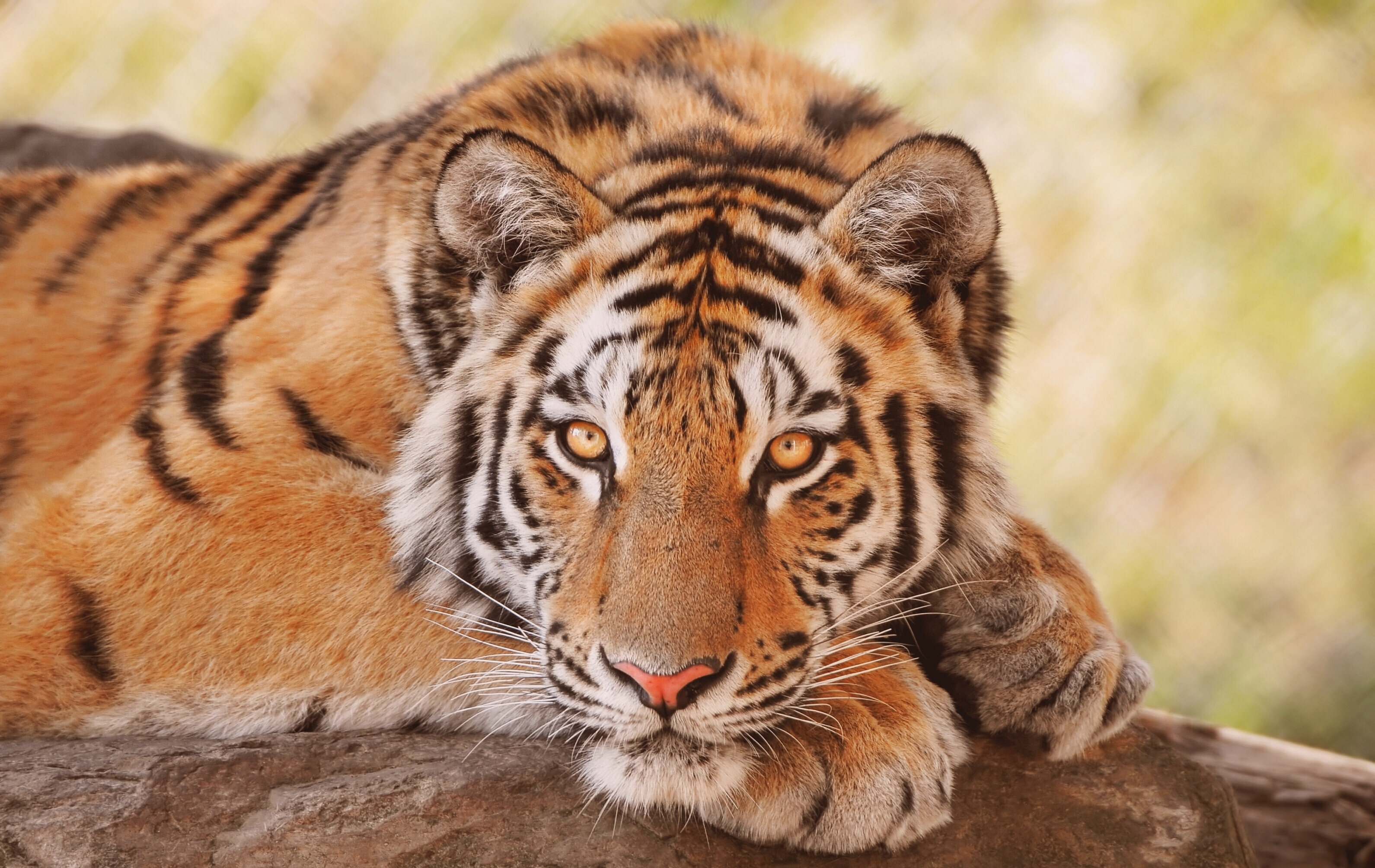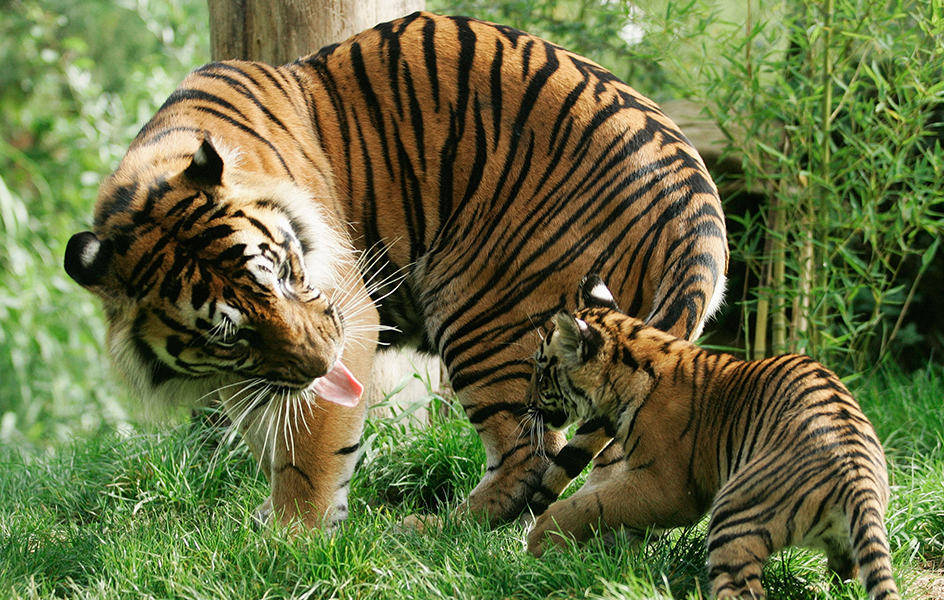Tiger is the largest member of the cat family. People admire the tiger for its strength and beauty. But they also fear the tiger because it has been known to kill and occasionally eat people. Yet wild tigers prefer to avoid human beings. Tigers that kill and eat people are most often sick or wounded animals. They can no longer hunt their natural prey. A hungry tiger may also attack people if prey is extremely scarce.
Wild tigers are found only in Asia. Until the 1800’s, many tigers lived throughout much of the southern half of the continent. Now only a few wild tigers remain in most countries. None of the animals are left in Iran and Pakistan.
Tigers can live in almost any climate. They need only shade, water, and food. Tigers are found in the rain forests of Thailand. They are also found in the hot, dry thorn woods of India and the cold, snowy, spruce forests of Siberia. In addition, tigers live in mangrove swamps, marshes, and tall grasslands. In general, tigers like to be in shade. They seldom go into the open plains as lions do.

The body of a tiger.
Most adult male tigers weigh about 420 pounds (190 kilograms). They are about 9 feet (2.7 meters) long, including a 3-foot (0.9-meter) tail. Most adult tigresses (females) weigh about 300 pounds (140 kilograms). They are 8 feet (2.4 meters) long. The tiger’s coat ranges from brownish-yellow to orange-red. It is marked by black stripes. Each tiger has a unique stripe pattern. The pattern is as distinctive as a human fingerprint. The fur on the throat, belly, and insides of the legs is whitish. Many tigers, especially the males, have a ruff of hair around the sides of the face. The tigers that live in Siberia, where winters are bitterly cold, have shaggy winter coats.

Some tigers have chalk-white fur with chocolate-brown or black stripes. These tigers, called white tigers, also have distinctive blue eyes. All other tigers have yellow eyes. White tigers are very rare in the wild. More than 100 white tigers live in the world’s zoos. They are all descendants of a white cub caught in India in 1951. A normal-colored tigress can give birth to a litter in which some of the cubs are white.

Tigers and lions look similar except for the color and length of their hair. The two species have even mated in zoos. They can produce offspring called ligers or tigons.
How a tiger hunts.
Tigers hunt large mammals, such as deer, antelope, wild cattle, and wild pigs. They may even attack young rhinoceroses and elephants. They also catch such small animals as peafowl, monkeys, and frogs. At times, tigers attack porcupines. But the porcupine’s quills may stick in the tiger’s face and body, causing painful wounds. In many parts of Asia, tigers prey on domestic cattle and water buffalo. This behavior is especially common where hunters have greatly reduced the tiger’s wild prey.

The tiger usually hunts at night, wandering along animal trails and dry stream beds. A tiger depends chiefly on its sharp vision and keen hearing. But it may also use its sense of smell. After stalking closely or waiting in cover, the tiger rushes at its prey in several bounds. Using its sharp claws, the tiger grasps the victim by the rump or upper body and pulls it down. The tiger’s large canine teeth are well suited for holding prey and for killing it.
Tigers are extremely swift for short distances. However, they soon tire. If a tiger fails to catch its prey quickly, it usually will give up. As long as a week may go by without a successful hunt. After a kill, the tiger drags the carcass (dead body) to thick cover. The tiger’s neck, shoulders, and forelegs are very powerful. A tiger can drag the body of a 500-pound (230-kilogram) water buffalo for 1/4 mile (0.4 kilometer). The tiger stays near the carcass until it has eaten everything except the large bones and stomach. A tiger may eat at least 50 pounds (23 kilograms) of meat in a night. A tiger often takes a long drink of water and a nap after a meal.
The life of a tiger.
Adult tigers usually live alone. But they are not unfriendly with one another. Two tigers may meet on their nightly rounds, rub heads in greeting, and then part. Several may share in eating a killed prey.
Loading the player...Camouflaged tiger
Adult males often claim their own territory and try to keep other males out. In areas with abundant prey, such territories may average about 20 square miles (52 square kilometers). The male tiger marks trees in his territory with his scent and urine. The scent tells other tigers that the territory is occupied. A male’s territory overlaps the territories of two or more females. Female territories are smaller than a male’s. Each tiger wanders alone. But they communicate with each other. In addition to scent, they communicate with sounds. The sounds include a roar that can be heard for up to 2 miles (3.2 kilometers) or more. Some tigers do not have territories and travel widely.

A tigress usually bears her first cubs when she is 31/2 to 4 years old. She carries the young within her body for about 31/2 months. She then gives birth to from one to six cubs, though usually two or three. Newborn cubs are helpless. They weigh about 2 to 3 pounds (0.9 to 1.4 kilograms). Tiger cubs, like kittens, are playful. They are wholly dependent on their mother for food until they are about a year old. Even then, they cannot kill a large animal. Cubs become fully independent at about 2 years old. Female cubs then often settle down in a territory near their mother. Males tend to roam far from their birthplace. Tigers live up to 20 years in the wild.
Tigers are good swimmers. They may swim across rivers or between islands. On hot days, they may cool off in water. Tigers can climb trees but usually do not.
Tigers and people.
People have greatly reduced the number of tigers by killing them and by clearing the forests in which they lived. Scientists identify several varieties of tigers, including the Bengal and Siberian tigers most commonly seen in zoos. Certain tiger varieties have already died out completely. Scientists consider all tigers to be in great danger. Several countries, especially India and Nepal, protect tigers in nature reserves. The survival of wild tigers depends on such efforts.

Tigers are easy to breed and raise in zoos. Cubs are popular with zoo visitors. Adult tigers are often trained to perform in circuses. They jump through hoops and are even ridden. Today, zoos do not need to capture any more tigers. Enough tigers are born in captivity.
